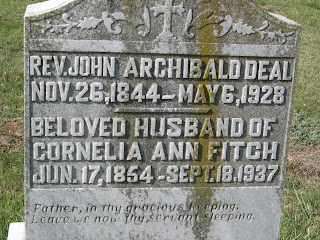A priest and performer considers religion, the arts, and the often thin space between sacred and secular, church and culture, pulpit and pew.
Thursday, November 10, 2011
Gifts from the Past
Perhaps the most significant and mysterious “fourth wall” is the one that divides this mortal life from the one that comes after. We speak of “passing on”, “crossing over”, “entering the Nearer Presence” – all euphemisms for death. Yet in this season of remembrance that began with All Saints’ and All Souls’ Days, it occurs to me that even this wall may be more permeable than we think, in a spiritual though not physical sense. We call to mind the saints of the Church, that “blest communion, fellowship divine”, knowing that across God’s spectrum of time and space we are united with them. We recall the saints of our own life and experience, the ones who have influenced us, challenging us to be our best, most faithful selves and encouraging us as they walk at least a portion of the journey alongside us. Or perhaps an ancestor we never knew but who, due to family lore and history is someone with whom we feel an affinity. My sabbatical travels, as well as an online retreat I’m taking that focuses on the gifts of our forebears, have brought the lives and stories of these people into much sharper focus for me. That is a gift that no wall can thwart.
Monday, November 7, 2011
All Saints Episcopal Community
All Saints’ Episcopal Community was formed several years ago in Franklin, North Carolina when the two churches of St. Agnes and St. Cyprian, both founded by my great-grandfather, united for common worship and mission. St. Agnes was founded first in the heart of town. It's the church where my paternal grandparents were married, and where my father was baptized and grew up. Those were the sad days of segregation, however, and when the Rev. John Deal realized that there was no Episcopal congregation for people of color - blacks and Native Americans (mostly Cherokee) - he founded St. Cyprian’s. When it became apparent that neither parish could sustain a full-time priest, the process of deciding whether or not to align the two congregations began. (St. Cyprian's had begun the process of intentional integration some years prior.) Several years ago a decision was reached and a new priest was called to serve both parishes. ASEC alternates its weekly liturgies between the two churches.
 |
| St. Cyprian's |
 |
| St. Agnes |
Merging two congregations is not as easy as it might sound. Many struggling parishes will vote to close rather than combine with another, even when such a partnership might give them a chance at new life. Communal identity is important; our buildings, our liturgical style and corporate piety, as well as our common memory, are all built into our vast sense of parochial “selfhood”. When churches are physically close enough to make such a merger feasible, their very proximity is often the result of two congregations in the same denomination not only wanting and expecting different things, but up until recently having sufficient resources to get them. I’m sure the process that resulted in the formation of All Saints Episcopal Community was thoughtful and prayerful, but also fraught with fear, reluctance, and probably some anger. It was no doubt very hard work. There was change, and with that change did come death of a sort. But it was the kind of death that leads to resurrection. Some of the members I spoke with still identify themselves as “Agnes” or “Cyprian”, but not in a way that sounded defensive, proud, or resentful. They are clearly committed to being Christ's hands and heart in this southern mountain town.
Thursday, November 3, 2011
Discovering
My husband and I just returned from a trip to Macon County, North Carolina. As a priest currently on a two-month sabbatical from the parish I serve, one of my goals during this time away has been to get better acquainted with my forebears on father’s side, especially as they have influenced my life in the Church. My great-grandfather, John Archibald Deal, was a priest and missionary in that mountainous region of western North Carolina. This was a heritage very special to my father; he lovingly recounted this family history when I was a girl, and we made several trips to the South from our home in Ohio (my father was a very reluctant Yankee!) to see friends and by then elderly relatives, my grandmother and her sisters chief among them.
But that generation died out, my father got older and less inclined to travel; I grew up. Over time the call to serve God as a priest in the Church became clear (I’ve often wondered if it isn’t genetic) and eventually I was ordained. I inherited many of my great-grandfather’s prayer books. And I developed a desire to get to know more about him and become familiar with the five churches he founded during his time in that mountain region that surrounds Franklin, where he was based and where my father and his brothers grew up.
Hence our recent journey south from our home in Chicago. We saw five churches in three days, visited with rectors and church members, and enjoyed beautiful weather, gorgeous colors, and stunning scenery. We found the graves of many of my relatives (one of which is shown below). All Souls’ Day seems the appropriate time to begin these reflections on my heritage and its influence on my life and vocation. I invite you to join me!
Subscribe to:
Posts (Atom)
